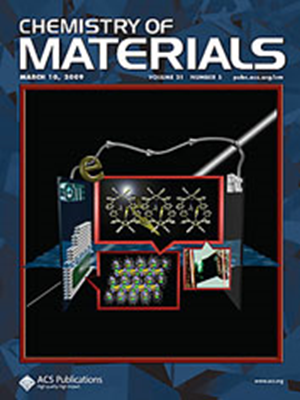通过机器学习势研究锂离子在Li6PS5Cl中扩散的原子机制
IF 7
2区 材料科学
Q2 CHEMISTRY, PHYSICAL
引用次数: 0
摘要
固态电解质在下一代锂电池中很有前途,但通常存在离子电导率低的问题。获得锂扩散机制的原子水平洞察对于合理设计具有优化离子电导率的固态电解质至关重要。锂离子在不同位置间的跳跃速率是评价锂离子扩散的常用方法。然而,先前的固态电解质计算研究发现,从跳变率分析和均方位移(MSD)计算中得出的最佳阴离子无序水平不一致。使用Li6PS5Cl作为模型固态电解质,本工作表明,使用有效跳变率,不包括非扩散的来回跳变,解决了这种差异。通过具有精确机器学习潜力的分子动力学模拟,从有效跳变率分析中确定了S/Cl阴离子无序水平的最佳范围为37.5%-50%,与MSD计算的最大离子电导率范围一致。进一步的分析说明了阴离子无序如何影响扩散途径的连通性和离子电导率。这种结合了机器学习和有效跳跃率的方法将整体电导率与微观机制联系起来,为指导优质固态电解质的设计提供了见解。本文章由计算机程序翻译,如有差异,请以英文原文为准。

Insights into the Atomic Mechanism of Lithium-Ion Diffusion in Li6PS5Cl via a Machine Learning Potential
Solid-state electrolytes are promising for next-generation lithium batteries but often suffer from low ionic conductivity. Gaining atomic-level insights into lithium diffusion mechanisms is crucial for rationally designing solid-state electrolytes with optimized ionic conductivity. The jump rate of lithium ions between sites is commonly used to evaluate lithium-ion diffusion. However, prior computational studies of solid-state electrolytes found inconsistent optimal anion disorder levels from jump rate analysis versus mean square displacement (MSD) calculations. Using Li6PS5Cl as a model solid-state electrolyte, this work demonstrates that using the effective jump rate, which excludes nondiffusive back-and-forth jumps, resolves this discrepancy. Through molecular dynamics simulations with an accurate machine learning potential, the optimal range of 37.5%–50% for the S/Cl anion disorder level was identified from the effective jump rate analysis, agreeing with the range for maximal ionic conductivity calculated from MSD. Further analyses illustrated how anion disorder impacts the connectivity of diffusion pathways and ionic conductivity. This combined machine learning and effective jump rate approach links bulk conductivity to microscopic mechanisms, delivering insights to guide the design of superior solid-state electrolytes.
求助全文
通过发布文献求助,成功后即可免费获取论文全文。
去求助
来源期刊

Chemistry of Materials
工程技术-材料科学:综合
CiteScore
14.10
自引率
5.80%
发文量
929
审稿时长
1.5 months
期刊介绍:
The journal Chemistry of Materials focuses on publishing original research at the intersection of materials science and chemistry. The studies published in the journal involve chemistry as a prominent component and explore topics such as the design, synthesis, characterization, processing, understanding, and application of functional or potentially functional materials. The journal covers various areas of interest, including inorganic and organic solid-state chemistry, nanomaterials, biomaterials, thin films and polymers, and composite/hybrid materials. The journal particularly seeks papers that highlight the creation or development of innovative materials with novel optical, electrical, magnetic, catalytic, or mechanical properties. It is essential that manuscripts on these topics have a primary focus on the chemistry of materials and represent a significant advancement compared to prior research. Before external reviews are sought, submitted manuscripts undergo a review process by a minimum of two editors to ensure their appropriateness for the journal and the presence of sufficient evidence of a significant advance that will be of broad interest to the materials chemistry community.
 求助内容:
求助内容: 应助结果提醒方式:
应助结果提醒方式:


